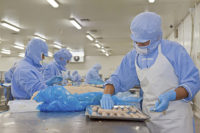Containing hazmats
Glass containers are commonly used in laboratory and cleanroom environments to hold a variety of products. These containers often house hazardous materials. In some cases, years of work and thousands of dollars worth of research could be contained within a single glass container. Plastic coating of the glass container can eliminate the potential for hazard or loss. The user can also reap the benefits of having the purity of glass with the safety of a plastic coating.If a plastic-coated container is dropped or broken, virtually all glass and contents are safely contained within the plastic coating. In addition to protecting the environment, products and people, the contents could also be salvaged and saved by mere filtration.
In selecting glass containers that are plastic-coated, be aware of a few things. Dipped coatings can leave a container that is too thick at the bottom to allow it to fit back into the existing packaging. Dipped coating can also leave drips on the handles and on the bottom, making it difficult for the container to sit level or be used in production lines. Most dipped coating also stops at the handle, leaving the area above it unprotected. Spraying of the plastic gives an even coverage. The container, up to the cap threads, can be plastic-coated without drips on the handles or bottom.
Another concern with plastic-coated glass containers is the plastic that is used. Quality plastic coatings are environmentally safe and can be incinerated without the concern of hazardous residue or emissions. Avoid containers coated with PVC/plastisol. They contain phthalates, which can contaminate the container's contents, especially high-purity solvents. PVC also can NOT be incinerated due to the dangers of hazardous residues or toxic emissions.
Chosen correctly, high quality plastic-coated glass containers used in cleanrooms and laboratories offer the shatter-resistance of plastic and the high chemical resistance of glass.
Protective lighting
Fluorescent lamps and other types of light bulbs are made of glass and can contain mercury, sodium and phosphors. If the light is broken, these components can cause injury, contamination of your products or work areas, and costly shutdown and cleanup time. Laboratory and cleanroom environments, where sanitation is crucial, present even more contaminant-critical areas.Although there are varying degrees of protective lighting, your best choice is to use plastic-coated light bulbs with a skin-tight coating. The skin-tight plastic coating has been applied directly to the light bulb and acts as an envelope to contain glass, mercury and phosphors in the event a light bulb is ever dropped or broken. This also means the work environment is never exposed to possible contamination from the light bulb's components.
Some coatings contain ultraviolet stabilizers, which are capable of blocking over 95 percent of the fluorescent lamp's ultraviolet emissions. UV light can spell trouble, causing the breakdown of photosensitive chemicals and materials, discoloration of food, fabric and artwork.
For some cleanrooms, such as microchip production and research facilities, elimination of ALL ultraviolet light is required. Any uncontrolled amount of UV could damage very expensive production or test materials. In these cases, gold colored plastic-coated protective fluorescent lamps that block all UV emissions can be used. These lamps are specially tailored for cleanrooms and other photosensitive environments seeking the safety of a plastic protection with the addition of the complete removal of UV radiation. These lamps come in a variety of standard fluorescent sizes.
